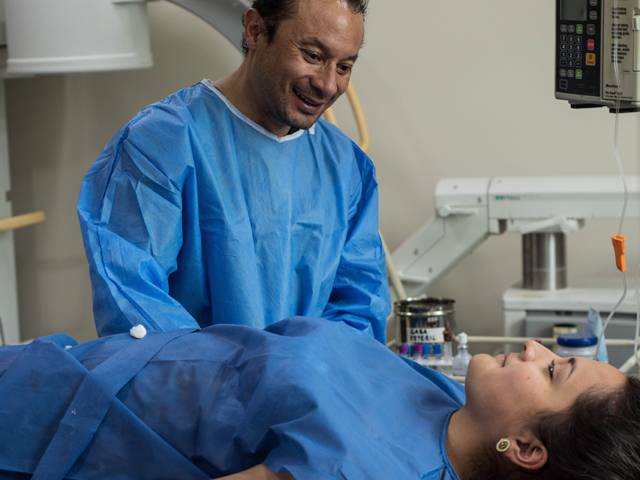Single Session Radiation Therapy Nearing A Reality

ANSTO's Australian Synchrotron has been working on an initiative that could substantially improve radiotherapy treatment for cancer patients.
A world-first study has shown that the newly- developed microbeam radiation therapy (MRT) could safely deliver radiation doses up to 20 times higher than is currently standard.
It is hoped that the study, conducted using the Synchrotron's Imaging and Medical beamline, could put us on the path to cancer patients needing just a single radiotherapy treatment.
Led by the Royal Women's Hospital, RMIT University and University of Melbourne, the research was undertaken in animal models" paving the way towards the first human trial.
Synchrotron medical beamline scientist, Dr Daniel Hausermann, said the research highlights the very real benefits that nuclear medicine can bring to the community.
"ANSTO's Synchrotron has enabled this exciting research, which has the potential to dramatically improve radiotherapy treatment for cancer patients," Dr Hausermann said.
"We all know someone who has been through radiotherapy to treat cancer and we know how hard that can be, both physiologically, and also emotionally as the treatments stretch out over time.
"This collaborative Synchrotron research could lead to dramatically improved outcomes for cancer patients, which has the potential to avoid the side-effects that come with radiation therapy."
Unlike conventional radiation therapy, which irradiates an entire area, killing both the tumour and damaging healthy cells, MRT is delivered in wafer-thin parallel beams of radiation.
Lloyd Smyth, lead researcher and radiation therapist from the Royal Women's Hospital, said the study published in the Nature Group journal, Scientific Reports, was a step toward more effective, less intrusive cancer treatment.
Mr Smyth said the new, more intense radiation treatment, delivered by ANSTO's Synchrotron, allowed healthy tissues to tolerate much higher doses and to recover.
"Our study was focused on understanding what dose of MRT could be safely given without harming the recipient," Mr Smyth said.
"We found that safe doses are remarkably high, and at least 10 to 20 times as high as doses usually considered safe in the clinic today.
"I am optimistic for the future of MRT to improve the quality of life for those suffering from this disease and reduce the time they spend receiving treatment.
"We are seeing a strange new paradigm, where the healthy cells in between the radiation beams are tolerating the treatment, while tumours lose their structure and die."
Australian Synchrotron Director, Professor Andrew Peele, said the research was another important example of how ANSTO and nuclear science can benefit the whole community.
"This research has the potential to improve cancer treatment and make the experience more comfortable and effective for patients," Professor Peele said.
The first trials are likely to involve patients with recurring brain, head and neck cancers. Advanced breast cancer patients could also benefit from MRT in the future.
For more information on ANSTO, see www.ansto.gov.au
Photo by Marlon Lara on Unsplash
A world-first study has shown that the newly- developed microbeam radiation therapy (MRT) could safely deliver radiation doses up to 20 times higher than is currently standard.
It is hoped that the study, conducted using the Synchrotron's Imaging and Medical beamline, could put us on the path to cancer patients needing just a single radiotherapy treatment.
Led by the Royal Women's Hospital, RMIT University and University of Melbourne, the research was undertaken in animal models" paving the way towards the first human trial.
Synchrotron medical beamline scientist, Dr Daniel Hausermann, said the research highlights the very real benefits that nuclear medicine can bring to the community.
"ANSTO's Synchrotron has enabled this exciting research, which has the potential to dramatically improve radiotherapy treatment for cancer patients," Dr Hausermann said.
"We all know someone who has been through radiotherapy to treat cancer and we know how hard that can be, both physiologically, and also emotionally as the treatments stretch out over time.
"This collaborative Synchrotron research could lead to dramatically improved outcomes for cancer patients, which has the potential to avoid the side-effects that come with radiation therapy."
Unlike conventional radiation therapy, which irradiates an entire area, killing both the tumour and damaging healthy cells, MRT is delivered in wafer-thin parallel beams of radiation.
Lloyd Smyth, lead researcher and radiation therapist from the Royal Women's Hospital, said the study published in the Nature Group journal, Scientific Reports, was a step toward more effective, less intrusive cancer treatment.
Mr Smyth said the new, more intense radiation treatment, delivered by ANSTO's Synchrotron, allowed healthy tissues to tolerate much higher doses and to recover.
"Our study was focused on understanding what dose of MRT could be safely given without harming the recipient," Mr Smyth said.
"We found that safe doses are remarkably high, and at least 10 to 20 times as high as doses usually considered safe in the clinic today.
"I am optimistic for the future of MRT to improve the quality of life for those suffering from this disease and reduce the time they spend receiving treatment.
"We are seeing a strange new paradigm, where the healthy cells in between the radiation beams are tolerating the treatment, while tumours lose their structure and die."
Australian Synchrotron Director, Professor Andrew Peele, said the research was another important example of how ANSTO and nuclear science can benefit the whole community.
"This research has the potential to improve cancer treatment and make the experience more comfortable and effective for patients," Professor Peele said.
The first trials are likely to involve patients with recurring brain, head and neck cancers. Advanced breast cancer patients could also benefit from MRT in the future.
For more information on ANSTO, see www.ansto.gov.au
Photo by Marlon Lara on Unsplash
MORE



